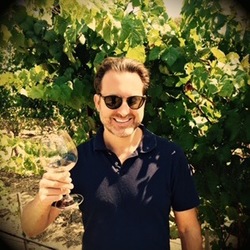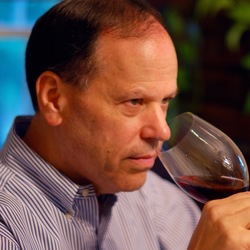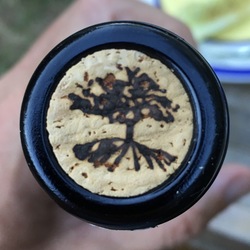Emblem
Agrapart & Fils (Pascal Agrapart)
Vénus A Avire Grand Cru Brut Nature Blanc de Blancs 2010
Venus is a stellar no dosage champagne. Definitely worth seeking out.
A unique terroir
A Brut Nature champagne
Blanc de Blancs Grand Cru
Vintage champagne
Always a vintage champagne, this cuvee comes from a single vineyard of 60 ares in AVIZE (Fosse aux pourceaux).
No heavy mechanical machines were used in the maintenance of this vineyard, which has solemnly been worked by man and by horse.
Vénus is the domain’s single vineyard emblem.
Bottled under cork.
Disgorged 2 months before the release date without dosage.
This cuvee is only available in bottle. — 4 years ago

Dirty & Rowdy
Unfamiliar Mourvedre 2017
Via Brooklyn Wine Exchange: Hardy Wallace is a bit of a superstar in the "New California" wine scene. He began his wine career in Atlanta, publishing a blog on the subject called Dirty South Wines. In 2009, he won a high-profile contest held by Murphy-Goode Winery in Sonoma, called "A Really Goode Job." Hardy beat out 2,000 other applicants for this stunt-job, acting as a sort of social media/pr coordinator for the winery. Upon completion of his six-month contract, he went to work for several legendary winemakers in the valley, including Cathy Corison (Chappellet, Corison) and Ehren Jordan (Turley, Failla). During this time, Hardy and his wife Kate also partnered with friends Matt and Amy Richardson to form a small label called Dirty & Rowdy Family Winery. For their first vintage, they purchased one ton of Mourvredre, the semi-obscure Provencal and Spanish variety that is rarely seen outside the context of a red blend in California.
Knowing that Dirty & Rowdy could distinguish itself in a ocean of Napa Valley Cabernet Sauvigon with this curious and brawny grape, Hardy & Co. quickly bet the farm on Mourvedre, as a vehicle to express different styles of winemaking as well as the terroir of multiple regions within California. Flash-forward to current day, where Dirty & Rowdy has become the king of California Mourvedre, bottling multiple cuvees each year that sell out almost immediately.
Dirty & Rowdy is a well-known emblem of the domestic natural wine scene as well. Hardy buys almost exclusively from organic growers, and doesn't filter, acidify, or alter his wines in anyway. Sulfur use is extremely low, and the overall philosophy is to be as hands-off as possible.
That is until 2017. The fact that Dirty & Rowdy has a wine to present at all for this vintage is a miracle. Flashback to mid-July last year. The growing season wasn't going all that well. Tremendous heat spikes created growth problems at almost all the vineyards Hardy sources grapes from. It's hard enough to monitor vine issues on one vineyard, let alone almost a dozen parcles scattered around six counties stretching from the Central Coast all the way out to the Sierra Foothills. A case of shingles went from bad to worse, spreading to his eyes. Hardy completely lost his vision for three days. Kate's brother Angus, a ski instructor and artist from Aspen, drove out to lend a hand with the impending harvest. On his way out, he was involved in single-car crash along a treacherous stretch of interstate and tragically lost his life.
Then the fires started.
Hardy and Kate, like many other producers who make wines in communal "crush" facilities located in urban areas around Sonoma and Napa, had hoped to ride out the fires and continue their wine production. The fires spread rapidly and threatened both their house and their winery, located in Petaluma. They left their wine in the midst of alcoholic fermentation, one of the most crucial and stressful times of the year for a winemaker even in the best of situations. When they were able to return eight days later, the winery was luckily undamaged. The wine, however, didn't fare so well. most vats had experienced "stuck fermentation," meaning that the native yeast died before eating all the sugar. Hardy, like most forward-thinking American winemakers, is a firm believer in natural fermentation. This no-brainer aspect to his wine was now an virtual impossibility. Plus, the vats contained high levels of volatile acidity or "VA," which creates an unfavorable "nail polish" quality in wine. A little bit of VA can give lift and energy to wine. Too much, however, renders the wine undrinkable.
At this point, Hardy thought to sell all the wine off in bulk for pennies on the dollar. Or perhaps create a second label to distance himself from what was surely going to be an atypical wine. Instead, he decided to combine almost every vat of his Mourvedre for the vintage (including lots of his most expensive fruit), and go into the "Unfamliar" territory of interventionist winemaker. Stuck lots were restarted using a variety of methods. When the wines finally fermented to dryness, he borrowed a "reverse osmosis" filtration system, perhaps the most modern of all the modern wine doohickeys. This contraption allowed Hardy to literally suck out the volatile acidity to bring it down to a pleasing level, as well as moderate and stabilize the alcohol. Then he filtered the wine. Basically, he did all the things he never thought he would ever want to do to wine.
The resulting wine is something that we have never seen before, both from Dirty & Rowdy and the Mourvedre grape, in general. Much of the wine fermented carbonically in tank, so the expression is much closer in style to Beaujolais than Bandol. It is so light on its feet, in fact, that Hardy believes this wine could take a serious chill. (Hence the reason we are trying to get you to try a California Mourvedre in the middle of a sweltering summer!) The tannins are pretty much non-existent, and the fruit is pretty and pure. There is a lovely little purple flower note in the middle of the wine, and a hint of smokiness on the finish (smoke taint from the fires? Or is this just some sort of phantom association because of the context? Either way, it adds depth and personality to this gorgeous wine.)
Since their "Annus Horribilis" of 2017, order and peace has been restored in Hardy & Kate's life. Their daughter Maple turns two in a few days. They celebrated the free-spirited life of their brother with scores of his friends and ski students at Aspen Mountain's opening day last November. The motto of the celebration, "Live Like Angus," has inspired hundreds and hundreds of beautiful social media posts. And this year's Spring release of Dirty & Rowdy wines from earlier vintages has quickly sold out around the country, gobbled up by ravenous collectors, restaurants, and retailers (like this one.)
But to Hardy, this "Unfamiliar" wine, which doesn't fit stylistically or financially into the rest of the D&R portfolio, will always represent something completely different: The best of a unthinkably bad situation. "It took a lot of blood, sweat, and tears to get that wine into bottle," Hardy wrote to us, just this morning. "Fortunately, it is fresh, delicious, soulful and somewhat of a Phoenix Rising from 2017. Though it is our least expensive wine ever, it is the wine I am most proud of." — 7 years ago
Mommessin
Les Caves Grandes Exception Moulin-à-Vent Gamay 2020
In 1865, Jean-Marie Mommessin founded winery. In 1889, Mommessin acquired La Grange Saint-Pierre, ancient buildings in Macon, originally belonged to Abbey of Cluny. Its key, the Key of St. Peter, became famous house emblem. Ruby color with aromas of dark berry fruit with notes of oak and floral. On the palate flavors of blackberry and currants with oak, floral, spice and earthy notes. Fine tannins, medium+ finish ending with fruit, oak and mineral character. — 2 years ago
Emblem
Napa Valley Cabernet Sauvignon 2014
Some great full but darker fruit. Medium tannins and length — 5 years ago
Folio (Michael Mondavi Family)
Emblem Chardonnay 2017
Big and delicious. Apple, pear, always there! — 6 years ago
Telescope Winery LLC
Bulgaria Red Blend 2014
Cool label. Not sure what the gold emblem has to do with telescopes. Lovely dark plumy color. Hint of rust on the edges. Very perfumed nose. Rose petals and smokes. Just a hint of wet rocks. Flavors are excellent. Cherry-berry stuff mixed with rose petals and plenty of tannin. Just a hint of olives. Sauna or smoke too. This is just great wine. — 3 years ago
Folio (Michael Mondavi Family)
Emblem Oso Vineyard Cabernet Sauvignon 2006
Dad really finding random bottles in the u fished basement — 5 years ago
Canard-Duchêne
Authentic Rosé Brut Champagne Blend
45% Pinot Noir / 30% Chardonnay / 25% Pinot Meunier
On the nose, strawberry shortcake, raspberry and citrus peels.
On the palate, red raspberry/currant and minerals. Dry.
At $40 I have not seen a better brut rosé bottle at this price point. This is the stuff I want to flow out of my faucet when I turn the handle! We can never have enough of this Champagne! Seek and you will be rewarded.
Producer Note:
Canard-Duchêne is unique in its origins, history and style. The Champagne house has been located in Ludes, in the Montagne de Reims National Park, since 1868, and is one of the original Grandes Marques. Its founders, Victor Canard and Leonie Duchêne, both well-known characters in Champagne, were granted the right by the Russian Imperial Family to adopt its coat of arms as the family emblem. The crowned two-headed eagle has thus appeared on every Canard-Duchêne label since the end of the 19th century. These authentic, original Champagnes combine fruit, intensity and complexity.
@David T
This is my version of your Billecart-Salmon Brut Rosé. — 8 years ago









Neil Valenzuela
Deep ruby color. Nicely balanced Cab- aromas of raspberries, blackberries and baking spices. Nice huckleberry on the palate, plum and oak on the finish.
🍇85% Cab, 8%Petite Sirah and 7%Petit Verdot.
🏅90 Points - Wilfred Wong — 2 months ago